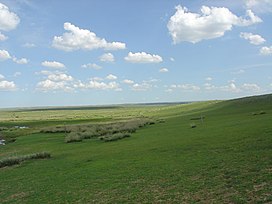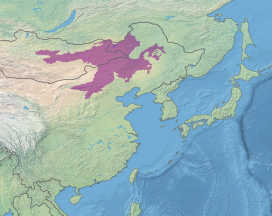322:
442:
38:
29:
595:
610:
The majority of people in the steppe are
Mongolian nomads. Families in the Mongolian steppe live in "gers" which are a type of large portable tent. Mongolians are also master horse riders so many families own many horses that roam the steppe. The people in the steppe use the animals there for their
601:
In the winter the grass becomes dry and very flammable, making wildfires more common. Grass recovers quickly from the fire, but trees do not. This partially explains the absence of trees in the area. There are also seasonal droughts in the grasslands, typically occurring during summer.
577:
is a very important prey base. Their presence in an area can limit the presence of other voles. Unfortunately, they can also very easily reduce vegetation if necessary. They are very good at burrowing in the terrain. They have a very big migration when it may get too
619:
The
Mongolian-Manchurian grassland faces threat from human expansion, though in most of its eastern area, it has not been altered by agriculture as much as its reaches in its western area, or similar grasslands in
841:
309:. The region features warm summers with decreasing rainfall from east to west, alongside frigid, extremely dry winters. Being relatively dry, from a combination of being landlocked and the proximity of the
354:
452:
Despite its landscaping, wildlife can be found in a variety of habitats not restricted solely to the open steppe. Many are programmed to traverse vast distances in
360:
965:
366:
173:
391:
201:
154:
70:
259:
866:
255:
247:
611:
food and drink. They also have a very prominent musical culture with a wide variety of traditional
Mongolian songs.
935:
925:
370:. The drier regions surrounding the Gobi host drought-tolerant grasses, together with forbs and low, spiny shrubs.
295:
950:
915:
960:
955:
920:
122:
945:
910:
232:
940:
930:
905:
468:
287:
251:
818:
503:) is also adapted to the mountainous woodlands of Northeast China and other similar ecoregions.
709:
539:
402:
236:
492:
has been introduced to similar grassland habitat in the United States for hunting and sport.
754:
670:
652:
496:
321:
267:
8:
806:
53:
525:
397:
532:
482:
345:
291:
228:
854:"Structure of threats to steppe biome in Russia - Conservation of steppes in Russia"
582:
560:
464:
occupies the belt of steppe, forests, and mountains stretching across much of Asia.
208:
193:
785:
819:"Northern Black Grouse (Lyrurus tetrix). Photo Gallery.Birds of Russian Far East"
553:
489:
453:
374:
275:
271:
181:
570:
specializes in seizing ground squirrels and other small mammals from their dens.
574:
518:
220:
177:
853:
200:) covers an area of 887,300 square kilometers (342,600 sq mi). This
899:
881:
868:
664:
658:
621:
378:
310:
239:
567:
528:(or onager) once covered vast steppe, though now exist in isolated patches.
507:
461:
446:
441:
415:
263:
549:
drinks very little water, instead, obtaining it mostly through their prey.
679:
212:
805:"Mongolian–Manchurian grassland". Dopa Explorer. Accessed 3 July 2021.
697:
632:
5.09% of the ecoregion is in protected areas. Protected areas include:
546:
328:
The dominant flora consists of medium to tall grasslands, dominated by
58:
246:
to the north. On the east and southeast, the grasslands transition to
703:
224:
204:
165:
161:
28:
594:
216:
169:
101:
37:
386:
243:
242:
form a transition zone between the grassland and the forests of
410:
377:
range support pockets of broadleaf deciduous forest, of either
107:
475:
472:
329:
157:
96:
65:
763:
Borzinskoe Sol`-ozero
Natural Monument (IUCN Category III)
766:
Sredneargunskij State
Natural Zakaznik (IUCN Category IV)
649:
Dornod Mongol
Strictly Protected Area (IUCN Category Ib)
563:
can be found in deciduous and coniferous woodland edges.
730:
Baga gazriin chuluu Nature monument (IUCN Category III)
556:
powerful beak can hammer large bones against hard rock.
514:), also known as the steppe marmot, inhabits the area
426:
Feathergrass – lives long since it is rarely consumed
742:
Darkhankhaan uul Nature monument (IUCN Category III)
637:
Lkhachinvandad uul Nature
Reserve (IUCN Category IV)
760:
Ikh gazriin chuluu
National Park (IUCN Category II)
739:
Bayantsagaani tal Nature
Reserve (IUCN Category IV)
736:
Kherlen Toono uul Nature
Reserve (IUCN Category IV)
727:
Ongon Tavan bulag Nature Reserve (IUCN Category IV)
724:
Choiriin Bogd uul Nature Reserve (IUCN Category IV)
700:
National Nature Reserve, Inner Mongolia Ramsar Site
485:feeds and hides in dense grassland and underbrush.
721:Orkhonii khundii National Park (IUCN Category II)
262:. On the southwest, the grasslands extend to the
897:
751:Jilin Momoge National Nature Reserve Ramsar Site
688:Toson-Khulslai Nature Reserve (IUCN Category IV)
456:and terrain by running, digging, and/or flying.
745:Undurkhaan uul National Park (IUCN Category II)
685:Khangain nuruu National Park (IUCN Category II)
966:Temperate grasslands, savannas, and shrublands
640:Batkhaan uul Nature Reserve (IUCN Category IV)
202:temperate grasslands, savannas, and shrublands
71:Temperate grasslands, savannas, and shrublands
733:Darkhan uul Nature Reserve (IUCN Category IV)
715:Khugnu-Tarna National Park (IUCN Category II)
691:Khar yamaat Nature Reserve (IUCN Category IV)
585:is found in the forest-steppe and grasslands.
718:Moltsog Els National Park (IUCN Category II)
694:Yakhi nuur Nature Reserve (IUCN Category IV)
676:Ugtam uul Nature Reserve (IUCN Category IV)
614:
748:Dariganga National Park (IUCN Category II)
661:Strictly Protected Area (IUCN Category Ib)
432:Lyme Grass – can provide food for animals
260:Central China loess plateau mixed forests
85:887,000 km (342,000 sq mi)
712:and its surrounding wetlands Ramsar Site
706:and its surrounding wetlands Ramsar Site
593:
440:
320:
589:
256:Northeast China Plain deciduous forests
215:, extending across central and eastern
898:
842:Environment in East Asia & Pacific
801:
799:
42:Map of ecoregion in China and Mongolia
313:, only select animals can live here.
248:temperate broadleaf and mixed forests
286:The climate is hypercontinental sub-
192:The Mongolian-Manchurian grassland (
796:
13:
778:
627:
231:. To the northeast and north, the
211:forms a large crescent around the
14:
977:
786:"Mongolian–Manchurian grassland"
422:There are also grasses such as:
227:, and then southwest across the
36:
27:
521:is found throughout the region.
373:The southwestern slopes of the
846:
835:
811:
667:(Mongolian Dauria) Ramsar Site
143:Mongolian-Manchurian grassland
22:Mongolian-Manchurian grassland
1:
771:
478:further north of the steppe.
471:lives and forages mainly in
219:into the eastern portion of
7:
542:has been reintroduced here.
147:Mongolian-Manchurian steppe
10:
982:
605:
281:
187:
501:Crossoptilon mantchuricum
469:black-billed capercaillie
197:
174:Chinese Autonomous region
131:
121:
116:
89:
81:
76:
64:
52:
47:
35:
26:
21:
615:Conservation and threats
436:
316:
301:or in the extreme east,
252:Manchurian mixed forests
223:and eastern and central
936:Flora of Northeast Asia
926:Flora of Inner Mongolia
355:Aneurolepidium chinense
951:Grasslands of Mongolia
916:Ecoregions of Mongolia
792:. World Wildlife Fund.
790:Terrestrial Ecoregions
598:
449:
429:Sheepgrass – perennial
361:Filifolium sibiricuman
325:
296:Köppen classifications
276:Greater Khingan Region
270:. It lies between the
266:, across which is the
151:Gobi-Manchurian steppe
16:Ecoregion in East Asia
961:Palearctic ecoregions
823:fareastru.birds.watch
597:
444:
403:Siberian silver birch
367:Cleistogenes sqarrosa
324:
956:Grasslands of Russia
921:Ecoregions of Russia
755:Landscapes of Dauria
671:Hustai National Park
653:Numrug National Park
643:Xianghai Ramsar Site
590:Environmental issues
497:brown eared pheasant
274:in the west and the
268:Ordos Plateau steppe
145:, also known as the
946:Grasslands of China
911:Ecoregions of China
878: /
757:World Heritage Site
646:Zhalong Ramsar Site
385:), or a mixture of
155:temperate grassland
127:Critical/endangered
123:Conservation status
941:Grasslands of Asia
931:Flora of Manchuria
906:Ecoregions of Asia
673:(IUCN Category II)
655:(IUCN Category Ib)
599:
540:Przewalski's horse
526:Mongolian wild ass
450:
407:Betula platyphylla
326:
168:covering parts of
554:bearded vulture's
535:is numerous here.
533:Mongolian gazelle
490:ringneck pheasant
483:Daurian partridge
392:Populus davidiana
383:Quercus mongolica
334:Stipa baicalensis
229:North China Plain
198:蒙古高原草原-内蒙古草原-东北草原
139:
138:
973:
893:
892:
890:
889:
888:
883:
879:
876:
875:
874:
871:
858:
857:
850:
844:
839:
833:
832:
830:
829:
815:
809:
803:
794:
793:
782:
583:Daurian hedgehog
561:northern goshawk
250:, including the
209:Palearctic realm
199:
40:
31:
19:
18:
981:
980:
976:
975:
974:
972:
971:
970:
896:
895:
886:
884:
880:
877:
872:
869:
867:
865:
864:
862:
861:
852:
851:
847:
840:
836:
827:
825:
817:
816:
812:
804:
797:
784:
783:
779:
774:
769:
630:
628:Protected areas
617:
608:
592:
454:extreme weather
439:
375:Greater Khingan
319:
284:
272:Altai Mountains
190:
182:Northeast China
112:
43:
17:
12:
11:
5:
979:
969:
968:
963:
958:
953:
948:
943:
938:
933:
928:
923:
918:
913:
908:
860:
859:
845:
834:
810:
795:
776:
775:
773:
770:
768:
767:
764:
761:
758:
752:
749:
746:
743:
740:
737:
734:
731:
728:
725:
722:
719:
716:
713:
707:
701:
695:
692:
689:
686:
683:
677:
674:
668:
662:
656:
650:
647:
644:
641:
638:
634:
629:
626:
616:
613:
607:
604:
591:
588:
587:
586:
579:
575:steppe lemming
571:
564:
557:
550:
543:
536:
529:
522:
519:Mongolian wolf
515:
504:
493:
486:
479:
465:
438:
435:
434:
433:
430:
427:
346:sheep's fescue
318:
315:
283:
280:
240:forest steppes
233:Selenge-Orkhon
221:Inner Mongolia
189:
186:
178:Inner Mongolia
137:
136:
133:
129:
128:
125:
119:
118:
114:
113:
111:
110:
105:
99:
93:
91:
87:
86:
83:
79:
78:
74:
73:
68:
62:
61:
56:
50:
49:
45:
44:
41:
33:
32:
24:
23:
15:
9:
6:
4:
3:
2:
978:
967:
964:
962:
959:
957:
954:
952:
949:
947:
944:
942:
939:
937:
934:
932:
929:
927:
924:
922:
919:
917:
914:
912:
909:
907:
904:
903:
901:
894:
891:
855:
849:
843:
838:
824:
820:
814:
807:
802:
800:
791:
787:
781:
777:
765:
762:
759:
756:
753:
750:
747:
744:
741:
738:
735:
732:
729:
726:
723:
720:
717:
714:
711:
708:
705:
702:
699:
696:
693:
690:
687:
684:
681:
678:
675:
672:
669:
666:
665:Mongol Daguur
663:
660:
659:Mongol Daguur
657:
654:
651:
648:
645:
642:
639:
636:
635:
633:
625:
623:
622:North America
612:
603:
596:
584:
580:
576:
572:
569:
565:
562:
558:
555:
551:
548:
544:
541:
537:
534:
530:
527:
523:
520:
516:
513:
512:Marmota bobak
509:
505:
502:
498:
494:
491:
487:
484:
480:
477:
474:
470:
466:
463:
459:
458:
457:
455:
448:
443:
431:
428:
425:
424:
423:
420:
419:
417:
412:
408:
404:
400:
399:
398:P. suaveolens
394:
393:
388:
384:
380:
379:Mongolian oak
376:
371:
369:
368:
363:
362:
357:
356:
351:
350:Festuca ovina
347:
343:
339:
335:
331:
330:feather grass
323:
314:
312:
311:Siberian High
308:
304:
300:
297:
293:
289:
279:
278:in the east.
277:
273:
269:
265:
261:
257:
253:
249:
245:
241:
238:
234:
230:
226:
222:
218:
214:
210:
206:
203:
195:
185:
183:
179:
175:
171:
167:
163:
159:
156:
152:
148:
144:
134:
130:
126:
124:
120:
115:
109:
106:
103:
100:
98:
95:
94:
92:
88:
84:
80:
75:
72:
69:
67:
63:
60:
57:
55:
51:
46:
39:
34:
30:
25:
20:
863:
848:
837:
826:. Retrieved
822:
813:
789:
780:
631:
618:
609:
600:
568:steppe eagle
511:
508:bobak marmot
500:
462:black grouse
451:
447:bobak marmot
421:
416:Salix rorida
414:
406:
396:
390:
382:
372:
365:
359:
353:
349:
341:
338:S. capillata
337:
333:
327:
306:
302:
298:
285:
264:Yellow River
191:
150:
146:
142:
140:
117:Conservation
885: /
682:Ramsar Site
680:Torey Lakes
294:, with the
213:Gobi Desert
900:Categories
882:47°N 119°E
828:2020-09-08
772:References
710:Ganga Lake
698:Dalai Lake
547:corsac fox
342:S. grandis
59:Palearctic
704:Buir Lake
292:semi-arid
225:Manchuria
205:ecoregion
166:East Asia
162:ecoregion
153:, in the
132:Protected
90:Countries
77:Geography
217:Mongolia
170:Mongolia
160:, is an
102:Mongolia
887:47; 119
606:Culture
409:), and
282:Climate
244:Siberia
237:Daurian
207:of the
194:Chinese
188:Setting
48:Ecology
411:willow
387:poplar
364:, and
340:, and
258:, and
196::
180:, and
172:, the
108:Russia
873:119°E
578:cold.
476:taiga
473:larch
437:Fauna
317:Flora
288:humid
158:biome
135:5.09%
97:China
66:Biome
54:Realm
870:47°N
581:The
573:The
566:The
559:The
552:The
545:The
538:The
531:The
524:The
517:The
506:The
495:The
488:The
481:The
467:The
460:The
395:and
235:and
141:The
82:Area
401:),
352:),
344:),
307:Dwb
305:or
303:Dwa
299:BSk
290:or
176:of
164:in
149:or
902::
821:.
798:^
788:.
624:.
445:A
418:).
358:,
336:,
254:,
184:.
856:.
831:.
808:.
510:(
499:(
413:(
405:(
389:(
381:(
348:(
332:(
104:,
Text is available under the Creative Commons Attribution-ShareAlike License. Additional terms may apply.

